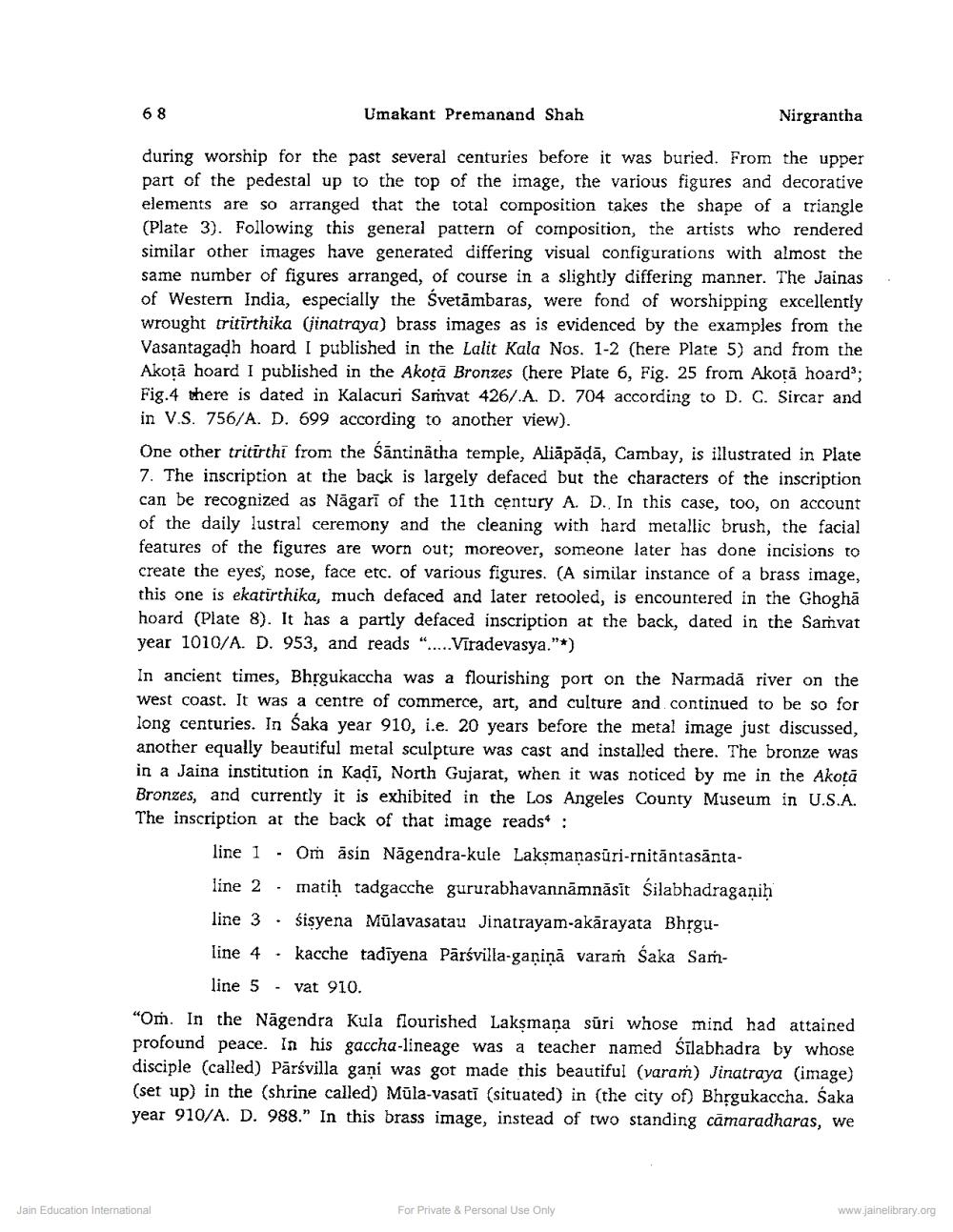Book Title: Some Notable Swetambara Jain Bronzes Author(s): Umakant P Shah Publisher: Z_Nirgrantha_1_022701.pdf and Nirgrantha_2_022702.pdf and Nirgrantha_3_022703.pdf View full book textPage 3
________________ 68 Umakant Premanand Shah Nirgrantha during worship for the past several centuries before it was buried. From the upper part of the pedestal up to the top of the image, the various figures and decorative elements are so arranged that the total composition takes the shape of a triangle (Plate 3). Following this general pattern of composition, the artists who rendered similar other images have generated differing visual configurations with almost the same number of figures arranged, of course in a slightly differing manner. The Jainas of Western India, especially the Svetāmbaras, were fond of worshipping excellently wrought tritīrthika (jinatraya) brass images as is evidenced by the examples from the Vasantagadh hoard I published in the Lalit Kala Nos. 1-2 (here Plate 5) and from the Akotā hoard I published in the Akota Bronzes (here Plate 6, Fig. 25 from Akoţă hoards; Fig.4 there is dated in Kalacuri Samvat 426/.A. D. 704 according to D. C. Sircar and in V.S. 756/A. D. 699 according to another view). One other tritirthi from the Säntinātha temple, Aliāpādā, Cambay, is illustrated in Plate 7. The inscription at the back is largely defaced but the characters of the inscription can be recognized as Nāgarī of the 11th century A. D. In this case, too, on account of the daily lustral ceremony and the cleaning with hard metallic brush, the facial features of the figures are worn out; moreover, someone later has done incisions to create the eyes, nose, face etc. of various figures. (A similar instance of a brass image, this one is ekatirthika, much defaced and later retooled, is encountered in the Ghoghā hoard (Plate 8). It has a partly defaced inscription at the back, dated in the Samvat year 1010/A. D. 953, and reads ".....Viradevasya."*) In ancient times, Bhrgukaccha was a flourishing port on the Narmadā river on the west coast. It was a centre of commerce, art, and culture and continued to be so for long centuries. In Śaka year 910, i.e. 20 years before the metal image just discussed, another equally beautiful metal sculpture was cast and installed there. The bronze was in a Jaina institution in Kadi, North Gujarat, when it was noticed by me in the Akotā Bronzes, and currently it is exhibited in the Los Angeles County Museum in U.S.A. The inscription at the back of that image reads : line 1 . Om åsin Nāgendra-kule Lakşmaņasūri-rnitāntasäntaline 2 • matiḥ tadgacche gururabhavannämnăsīt silabhadraganih line 3 • śisyena Mūlavasatau Jinatrayam-akārayata Bhrguline 4 · kacche tadiyena Pārsvilla-ganiņā varaṁ Śaka Sam line 5 . vat 910. "Om. In the Nägendra Kula flourished Laksmana sūri whose mind had attained profound peace. In his gaccha-lineage was a teacher named Silabhadra by whose disciple (called) Pārsvilla gani was got made this beautiful (varam) Jinatraya (image) (set up) in the (shrine called) Mūla-vasati (situated in the city of) Bhrgukaccha. Saka year 910/A. D. 988." In this brass image, instead of two standing camaradharas, we Jain Education International For Private & Personal Use Only www.jainelibrary.orgPage Navigation
1 2 3 4 5 6 7 8 9 10
